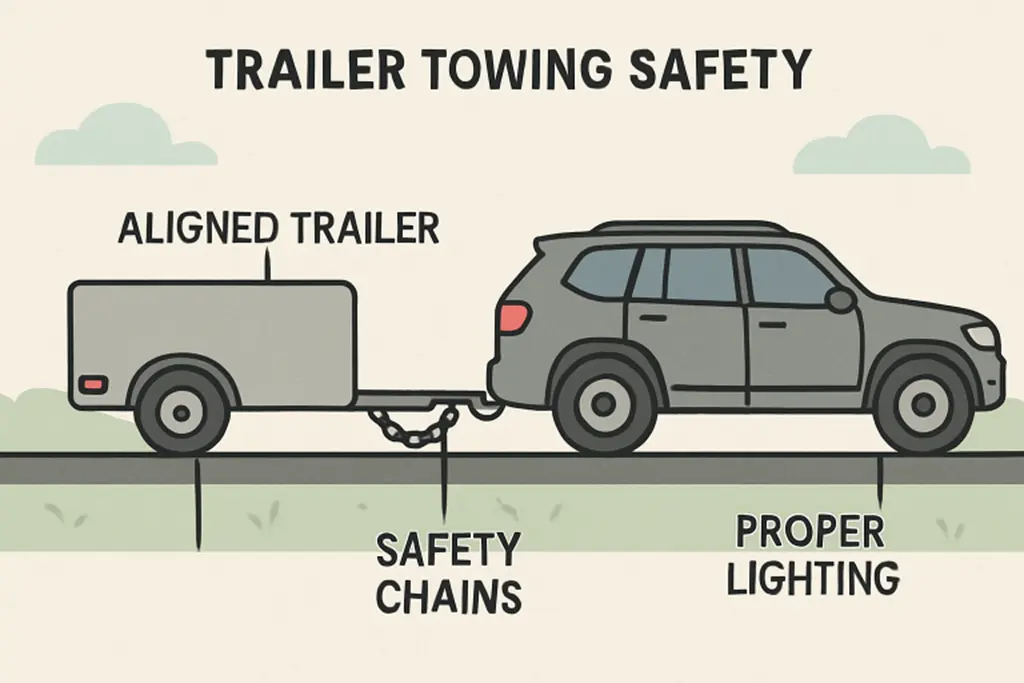Towing a trailer is far more complex than simply hitching up and taking off down the road. It involves detailed preparation, understanding mechanical limits, and a sense of responsibility for your safety and everyone else on the road. Whether you’re setting out for a weekend camping trip with your family, hauling a boat to the lake, or transporting heavy equipment for a work project, each scenario requires a thoughtful approach. Safety hinges on careful planning, especially regarding towing accessories like a robust drop hitch, effective load distribution, and knowledge of your vehicle’s capabilities. By investing a bit of time in preparation and using reliable equipment, you protect your assets and contribute to safer highways for everyone.
Adhering to expert towing guidelines and using appropriate equipment are non-negotiable elements of safe towing. This applies whether you’re an experienced tower or a newcomer. By thoroughly checking your tow vehicle and trailer, confirming the towing setup, and adjusting your driving behavior to account for the extra weight and length, you drastically reduce the risk of an accident. A well-informed driver is a safe driver, and one of the most practical ways to become more confident behind the wheel is by following established safety procedures. By doing so, towing becomes a manageable—and even enjoyable—experience for anyone willing to respect the process.
Understanding Towing Capacity
Before you even begin to tow, you need to carefully review your vehicle’s towing capacity. Exceeding the manufacturer’s recommended limit can lead to catastrophic damage, not just to your engine, but also to your transmission, suspension, and brakes. Every vehicle, from pickup trucks to SUVs, has limits that include both the trailer and its contents, as well as the added weight of any equipment or passengers. Exceeding these guidelines—even by a small amount—puts you at risk for mechanical breakdowns and loss of vehicle control, especially at highway speeds or when driving through mountainous terrain. Consult your owner’s manual, or rely on resources like the vehicle manufacturer’s website, to clearly establish your towing limits. Having a clear understanding prevents costly mistakes, voided warranties, and, most critically, keeps you and others out of harm’s way.
It’s also crucial to account for every segment of weight being towed, including fuel or water tanks if you’re hauling an RV or a work trailer. Some drivers make the mistake of underestimating cumulative weight, especially when loading up for a long trip. To verify your setup, consider using a certified weigh station or portable scale to make sure no component is overloaded.
Choosing the Right Towing Equipment
Equally important to knowing your towing capacity is equipping your setup with properly rated tools and accessories. The heart of safe towing lies in choosing a hitch and receiver that are built to handle the maximum loaded weight of your trailer. A drop hitch can be especially useful, allowing you to align the trailer parallel with the ground, preventing dangerous sway and increasing maneuverability. Check that all components—the ball mount, receiver, hitch pin, and coupler—show no signs of cracks, rust, or excessive wear, as overlooked defects can quickly turn into a disaster.
Additionally, never underestimate the importance of safety chains, which should always be crossed under the tongue of the trailer to provide a failsafe if the hitch becomes disconnected. Each trip should start with a check of all trailer lighting, including turn signals and brake lights, as malfunctioning lights are both illegal and highly unsafe. Tires are another point of frequent oversight. Be certain that all tires, from your vehicle to your trailer, are properly inflated and have sufficient tread. Investing in high-quality accessories, such as a reliable towing system, means simpler operation, more predictable handling, and peace of mind whenever you’re on the road.
Proper Load Distribution
The Importance of Balanced Weight
The manner in which you load your trailer has a profound effect on road handling and safety. Improperly distributed loads can result in noticeable instability—trailer sway, jackknifing, or flipping are genuine risks if weight isn’t carefully balanced. For optimal safety, about 60% of the total cargo should rest in the front half of the trailer, with all sides balanced as evenly as possible. Securing every item, large or small, prevents dangerous shifts that might occur when accelerating, braking, or taking sharp turns. Loose cargo can slide to one side, leading to sudden swaying that can quickly spiral out of control.
A key aspect of weight distribution is maintaining proper “tongue weight”—the downward force exerted on the hitch, which should typically be 10-15% of your total trailer weight. Too little tongue weight can cause excessive trailer sway; too much can compromise your vehicle’s steering. Many modern hitches and devices are equipped with tongue-weight scales, offering a simple and accurate way to verify your setup.
Adjusting Driving Habits
Techniques for Safer Towing
Hauling a trailer fundamentally changes how your vehicle handles, requiring a patient, cautious approach each time you’re behind the wheel. Extra length means you must be deliberate with turns and maneuvers, allowing space for the trailer to track through corners. Added weight extends your vehicle’s stopping distance, so it’s essential to increase your following distance and anticipate braking far earlier than you would driving unladen. Slow your speed, which improves stability and reduces the risk of the trailer swaying out of control, especially in windy or wet conditions.
Regularly check your side mirrors for a clear view of both the trailer and approaching vehicles. When overtaking, merging, or changing lanes, give yourself ample room and execute any adjustments gradually. Plan all wider turns in advance to ensure your trailer wheels do not jump curbs or veer into adjacent lanes. For those new to towing, it’s highly recommended to practice maneuvering and backing up in a vacant parking lot until you become comfortable with how the combined vehicle-and-trailer setup behaves. This hands-on experience will greatly enhance your skills and confidence when facing the challenges of highway or city traffic.
Regular Inspections and Maintenance
What to Check Before Every Trip
Never underestimate the value of routine inspections; these checks are essential for preventing accidents and ensuring mechanical reliability, whether towing for a few miles or across several states. Each time you tow, begin by inspecting tire pressure and tread on both the tow vehicle and trailer, ensuring there are no signs of excessive wear or damage. Test the braking system and confirm that all lights—including brake, tail, and turn signals—are in good working order, as functional lighting is both a legal and practical requirement for safety.
Check that the hitch is securely latched and the safety chains are correctly crossed beneath the tongue, providing a vital backup in the event of a separation. During long hauls, stop periodically to reinspect these components, as vibration and shifting loads can cause connections to loosen over time. Listen carefully for any unexpected noises or vibrations, which could indicate underlying issues needing prompt attention. Addressing minor problems early can save time and money and, most importantly, prevent dangerous situations on the road.
Conclusion
Safe towing results from a blend of diligent preparation, using the right gear, and actively adjusting your driving style. By taking these rules to heart—beginning with the basics of understanding your vehicle’s capacity, consistently choosing reliable towing accessories, ensuring balanced loads, and staying vigilant throughout your journey—you protect yourself, your passengers, and everyone sharing the road. Prioritizing ongoing inspection and high-quality equipment, such as a dependable drop hitch, gives you unmatched stability wherever you travel. Ultimately, towing safety is about more than compliance; it’s a guiding principle that ensures every journey is as secure and efficient as possible for all involved.








